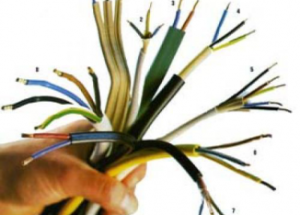If in the apartment before your appearance someone has already made the calculation of the electrical wiring and carried out its installation, consider that you are damn lucky. There will be no need to climb with a tape measure in the hands of the apartment, make measurements of the location of future outlets and lamps. Well, and if this did not happen, do not despair. Calculate the wiring yourself.
Content
Key moments of design and calculation of electrical wiring
It is advisable to start calculating the wiring from the layout of the wiring plan and the wiring diagram.

When designing electrical wiring with your own hands, you must remember the following conditions:
• about the earthing of the wiring
• power of installed electrical appliances
• type of conductor material
• choice of cable cross-sections
• cable laying conditions
• connection of the electricity meter
• application of protection (differential or RCD).

Determination of the total power of household appliances
The calculation of electrical wiring should be based on a correct calculation of the power of the consumer, taking into account the power of household electrical appliances.
In any apartment there are household heating appliances that have the following capacity:
• electric water heater - 2 kW
• air conditioning - 2 kW
• Iron - 2 kW
• electric kettle - 2 kW
• washing machine - 1 kW
• TV - 1 kW
• refrigerator - 0,7 kW
• microwave oven - 0,7 kW
• Lighting the apartment - 0,5 kW
• small household electrical appliances.

With a minimum power consumption, this figure is 12 kW from the normatively put on an apartment of 15 kW. Depending on the area of the apartment for a typical one-bedroom apartment with a total area of more than 53 sq.m. The specific load increases by 1 percent of each additional area of one square meter.
Next, the wiring is divided into several groups:
• Room outlets
• kitchen sockets
• bathroom sockets
• outlet of the corridor
• Lighting the apartment.
For kitchen outlets it is necessary to take into account the maximum daily peak load that the refrigerator, microwave oven, electric kettle and other household appliances will consume.
For bathroom sockets, you need to take into account the powerful water heaters and washing machine.

Selection of the cable and electrical cable section
Thus, we will determine the power consumption of the connected household appliances and the voltage of the apartment network. These parameters are paramount for calculating the amount of current flowing through the cable. Then, from the existing table of permissible currents for the cable and wires and in accordance with the Rules of the Electrical Installation Device (PUE), the corresponding cable section is selected.

The cross-section of a cable or an electric wire is recommended to be selected with a small margin for current. This eliminates the possibility of heating the wiring. When choosing the cable brand, it must be taken into account that different cable brands and electric wires are used for different operating conditions. The most popular for residential applications are cables with a single-wire residential type VVGng and VVG ("hard"), as well as with multiwire cores - PBPP, PVS ("flexible").
How to correctly choose the cable section for wiring yourself the following video will help you.
Measuring and counting the cable length
Before the wiring is installed, the length of the future cable location is measured. The measurement is made taking into account the total number of electrical appliances. The resulting total is multiplied by 15 percent (standard stock, taking into account possible inaccuracies in calculations or measurements). After calculating the length of the cable and wires, you must also determine the cost of wiring.

One can resort to an approximate method of calculating the total length of a similar cable for electrical wiring. For this, the area of the room in sq. M. meters is multiplied by 2. The resulting frightening digit of cable length is included in the total cost of the wiring. It is also necessary to include the cost of the diffuser or RCD, as well as the total number of sockets to be installed.
The cost of wiring depends also on the chosen installation method.
Wiring Wiring Modes
The installation of electrical wiring in the apartment itself can be done in several ways. Basic Wiring Modes:
• hidden
• open.

Hidden the installation of the wiring includes the installation of the cable either in the walls or underneath the hiding surfaces. It can be suspended ceilings, the space between the slabs, under the floor. To install or transfer switches or sockets during the electrical wiring of the apartment, the most laborious work is the strobing of the walls.

For the purpose of mounting the open wiring, technological cavities are created for laying the cable. Shtroblenie with their own hands of reinforced concrete monolithic walls with a perforator is hard work. Without special skills and special equipment, the wiring will be very problematic.
To prepare and apply strobilieniya must use special equipment. The concealed type of installation is applicable for apartments, and is not used for wooden premises.

Open the installation of electrical wiring involves the process of laying the cable in the corrugated pipe or trays.
Any method of installing electrical wiring is regulated by regulatory documents and suggests the expediency of its use.
In the case of replacing the electrical wiring in the apartment with their own hands, it is recommended to replace the old electrical wiring immediately. In practice, replacing old wiring costs less than partial replacement of individual sections.

Features of the national installation of electrical wiring are presented with thorough and reliable accuracy in the video. After watching this video, you can safely get down to work.



















